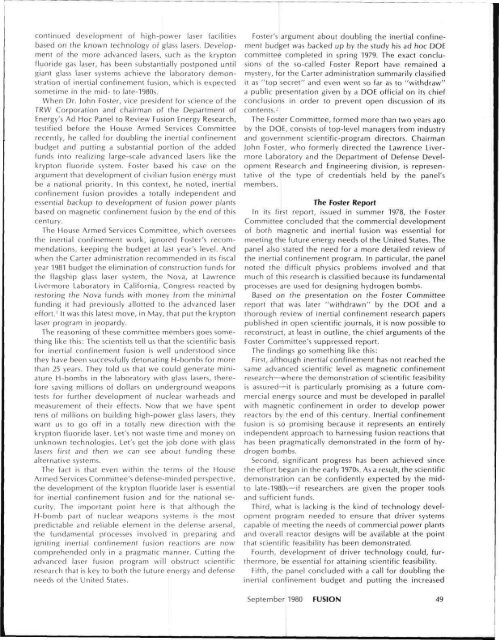fusion energy foundation
fusion energy foundation
fusion energy foundation
- No tags were found...
You also want an ePaper? Increase the reach of your titles
YUMPU automatically turns print PDFs into web optimized ePapers that Google loves.
continued development of high-power laser facilitiesbased on the known technology of glass lasers. Developmentof the more advanced lasers, such as the kryptonfluoride gas laser, has been substantially postponed untilgiant glass laser systems achieve the laboratory demonstrationof inertial confinement <strong>fusion</strong>, which is expectedsometime in the mid- to late-1980s.When Dr. John Foster, vice president for science of theTRW Corporation and chairman of the Department ofEnergy's Ad Hoc Panel to Review Fusion Energy Research,testified before the House Armed Services Committeerecently, he called for doubling the inertial confinementbudget and putting a substantial portion of the addedfunds into realizing large-scale advanced lasers like thekrypton fluoride system. Foster based his case on theargument that development of civilian <strong>fusion</strong> <strong>energy</strong> mustbe a national priority. In this context, he noted, inertialconfinement <strong>fusion</strong> provides a totally independent andessential backup to development of <strong>fusion</strong> power plantsbased on magnetic confinement <strong>fusion</strong> by the end of thiscentury.The House Armed Services Committee, which overseesthe inertial confinement work, ignored Foster's recommendations,keeping the budget at last year's level. Andwhen the Carter administration recommended in its fiscalyear 1981 budget the elimination of construction funds forthe flagship glass laser system, the Nova, at LawrenceLivermore Laboratory in California, Congress reacted byrestoring the Nova funds with money from the minimalfunding it had previously allotted to the advanced lasereffort. 1 It was this latest move, in May, that put the kryptonlaser program in jeopardy.The reasoning of these committee members goes somethinglike this: The scientists tell us that the scientific basisfor inertial confinement <strong>fusion</strong> is well understood sincethey have been successfully detonating H-bombs for morethan 25 years. They told us that we could generate miniatureH-bombs in the laboratory with glass lasers, thereforesaving millions of dollars on underground weaponstests for further development of nuclear warheads andmeasurement of their effects. Now that we have spenttens of millions on building high-power glass lasers, theywant us to go off in a totally new direction with thekrypton fluoride laser. Let's not waste time and money onunknown technologies. Let's get the job done with glasslasers first and then we can see about funding thesealternative systems.The fact is that even within the terms of the HouseArmed Services Committee's defense-minded perspective,the development of the krypton fluoride laser is essentialfor inertial confinement <strong>fusion</strong> and for the national security.The important point here is that although theH-bomb part of nuclear weapons systems is the mostpredictable and reliable element in the defense arsenal,the fundamental processes involved in preparing andigniting inertial confinement <strong>fusion</strong> reactions are nowcomprehended only in a pragmatic manner. Cutting theadvanced laser <strong>fusion</strong> program will obstruct scientificresearch that is key to both the future <strong>energy</strong> and defenseneeds of the United States.Foster's argument about doubling the inertial confinementbudget was backed up by the study his ad hoc DOEcommittee completed in spring 1979. The exact conclusionsof the so-called Foster Report have remained amystery, for the Carter administration summarily classifiedit as "top secret" and even went so far as to "withdraw"a public presentation given by a DOE official on its chiefconclusions in order to prevent open discussion of itscontents. 2The Foster Committee, formed more than two years agoby the DOE, consists of top-level managers from industryand government scientific-program directors. ChairmanJohn Foster, who formerly directed the Lawrence LivermoreLaboratory and the Department of Defense DevelopmentResearch and Engineering division, is representativeof the type of credentials held by the panel'smembers.The Foster ReportIn its first report, issued in summer 1978, the FosterCommittee concluded that the commercial developmentof both magnetic and inertial <strong>fusion</strong> was essential formeeting the future <strong>energy</strong> needs of the United States. Thepanel also stated the need for a more detailed review ofthe inertial confinement program. In particular, the panelnoted the difficult physics problems involved and thatmuch of this research is classified because its fundamentalprocesses are used for designing hydrogen bombs.Based on the presentation on the Foster Committeereport that was later "withdrawn" by the DOE and athorough review of inertial confinement research paperspublished in open scientific journals, it is now possible toreconstruct, at least in outline, the chief arguments of theFoster Committee's suppressed report.The findings go something like this:First, although inertial confinement has not reached thesame advanced scientific level as magnetic confinementresearch—where the demonstration of scientific feasibilityis assured—it is particularly promising as a future commercial<strong>energy</strong> source and must be developed in parallelwith magnetic confinement in order to develop powerreactors by the end of this century. Inertial confinement<strong>fusion</strong> is so promising because it represents an entirelyindependent approach to harnessing <strong>fusion</strong> reactions thathas been pragmatically demonstrated in the form of hydrogenbombs.Second, significant progress has been achieved sincethe effort began in the early 1970s. As a result, the scientificdemonstration can be confidently expected by the midtolate-1980s—if researchers are given the proper toolsand sufficient funds.Third, what is lacking is the kind of technology developmentprogram needed to ensure that driver systemscapable of meeting the needs of commercial power plantsand overall reactor designs will be available at the pointthat scientific feasibility has been demonstrated.Fourth, development of driver technology could, furthermore,be essential for attaining scientific feasibility.Fifth, the panel concluded with a call for doubling theinertial confinement budget and putting the increasedSeptember 1980 FUSION 49
















